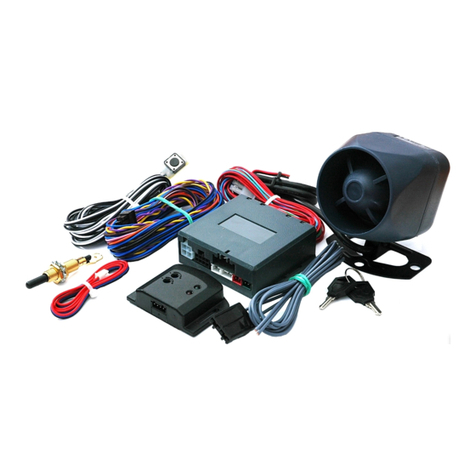
Press ‘Mode ’ button once
Press ‘PANIC’ button once
Sirens sound immediately and strobe
flashes latched for 20 minutes
A record of an activated siren
warns of a possible intrusion.
If there was an intrusion whilst you were
before you enter your property.
When you disarm the system, the
emit beeps for 20 seconds and
warning tone can be heard
when the system is setting from
The SolarGuard will emit 5 chirps and 5
LED flashes instead of 1 chirp to
confirm arming status. No need to
out the exact detector on low battery.
You will be warned of a low detector battery by emitting 5 chirps from SolarGuard console
when you arm the system. Detectors with a l
ow battery will continue to operate normally,
but must be replaced within 14 days of the initial warning.
Before removing a detector battery cover to install a new battery remember to enter the
Engineer Battery Change command (See SYSTEM TEST AFTER COMPLE
INSTALLATION), as this will prevent the tamper switch from activating the sirens on the
acid rechargeable battery installed inside the SolarGuard will last for 2 to
3 years. This is achieved by the periodic charging from t
he solar panel and extremely
small amount of power required by the SolarGuard. It is recommended that you change
the battery every 2 years
to maintain best performance
Detector batteries are designed to last up to 12 months. A detector with a low batter
cause the SolarGuard to emit 5 chirps with 5 LED flashes when you arm the system. The
emote control battery will last up to 2 years. A low battery will result in poor transmitting
The following battery types are required for battery replace
Your SolarGuard requires very little maintenance. Howeve
r, a few simple tasks will ensure
its continued reliability and operation.
Clean the Solar panel lens by using a soft, damp cloth at least once a year. Preferably
. This will ensure that the Solar Panel receives all the available
Failure to maintain charge to the unit will result in the rechargeable battery running
he unit must be recharged from a
DC12V/500mA mains adaptor. The complete charge time is approximately 10 hours.
acid rechargeable battery has a typical life of 2 to 3 years
and needs no maintenance during this period providing the battery is kept charged.
The battery will be damaged if it is stored in a discharged state.
be cleaned of any cobwebs or other insects that like corners of
ceilings or walls. Frequent use of fly spray is recommended.
Any number of PIR movement detectors,
agnet detector transmitters
may also be upgraded by installing the MHA2000 control panel. This
keypad operation, LED zone light indications, as well
as allowing you customize the operation of the system including features
mode, programmable zone set
up and many more yet still retaining the totally wire
See our website for more information





























